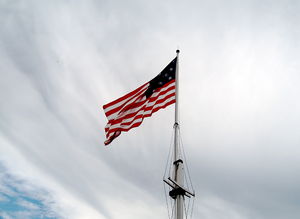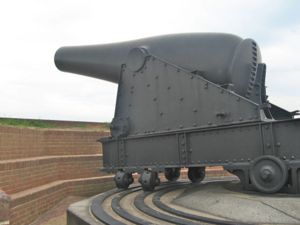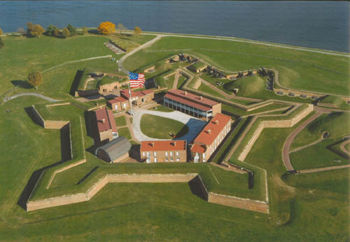Fort McHenry
|
Fort McHenry (1776-1912) - Fort McHenry was originally named Fort Whetstone after its location on Whetstone Point, Baltimore, Baltimore County, Maryland. In 1798 it was renamed Fort McHenry in honor of James McHenry, Secretary of War under George Washington. The location ensured that enemy ships sailing into Baltimore would have to pass the fortifications.
War of 1812 (1812-1814) The British attacked during the War of 1812 on 13 Sep 1814. For 25 hours the British bombarded Fort McHenry from ships outside of Baltimore harbor. The fort's defenders held firm, and Baltimore was saved. Frances Scott Key observed the bombardment and was inspired to write "The Star-Spangled Banner" when he saw the 15 star U.S. garrison flag being raised when dawn broke on the 14th of September 1814. As they raised the flag, the troops in the fort fired their guns and played “Yankee Doodle” in celebration of their victory.
U.S. Civil War (1861-1865)During the U.S. Civil War Union troops were stationed at Fort McHenry to help keep Baltimore out of the hands of those who would have Maryland join the southern rebellion. The fort's guns were turned toward the city. The fort was used as a temporary prison where political prisoners suspected of being Confederate sympathizers were held, often without trial. Following the Battle of Gettysburg in early July 1863 nearly 7,000 Confederate soldiers were detained in the fort. The prisoner capacity of the fort was listed as 600 but up to 6,957 were held at one time. There were 37 prisoner escapes and 33 deaths listed. Fort McHenry remained active until 20 Jul 1912 when the last active garrison left the fort. Between 1915 and 1917 the City of Baltimore used the site as a city park and beach. World War I (1917-1918)In 1917 the U.S. Army used the site to establish U.S. General Hospital No. 2 for returning wounded veterans of World War I. It was the largest military hospital in the United States with over 100 temporary buildings. When the war ended, the need for the hospital slowly diminished and in 1925 the hospital was torn down. In 1925 Fort McHenry was made a national park, and it was transferred to the care of the National Park Service in 1933. Fort McHenry was redesignated a National Monument and Historic Shrine in 1939. It is the nation's only Historic Shrine. World War II (1941-1945)During World War II the Fort served as a Coast Guard Training Center for fire control and port defense.
Current StatusNow part of Fort McHenry National Monument and Historic Shrine. Large numbers of period cannons and carriages. Must see!
Sources:
Links:
Visited: 4 Apr 2009, 4 Sep 2006 Picture Gallery
| ||||||||||||||||||||||||||||||||||||||||||||||||||||||||||||||||||||||||||||||
- Visited
- All
- Maryland Forts
- Maryland All
- Coastal Forts
- First System Forts
- Second System Forts
- War of 1812 Forts
- U.S. Civil War Forts
- Civil War Union Prisons
- World War I Forts
- World War II Forts
- Harbor Defense of Baltimore
- Harbor Defense of Baltimore - War of 1812
- National Park
- Fort McHenry
- Maryland Baltimore County
- Must See
- 2009 CDSG Meeting

































